Series at a Glance:
A Disturbing Trend
Swastikas painted on buildings, a Mexican woman beaten and left for dead and verbal threats shouted by drivers on the road.
These are just some of the approximately 2,300 recently documented acts of hate hurled toward specific groups in the tri-state area.
Hate at Home: A Seemingly Growing Problem in Our Communities
News 12 Westchester and Hudson Valley have compiled, researched and gathered hate-crime data that shows disturbing incidents of hate at a time when the country seems more divided than ever. The incidents have left a deep impact on individuals and communities in New York, New Jersey and Connecticut.

Statistics researched for this project show the Jewish community to be among the most common target of hate. However, the incidents overall impact a wide range of victims from a variety of backgrounds.
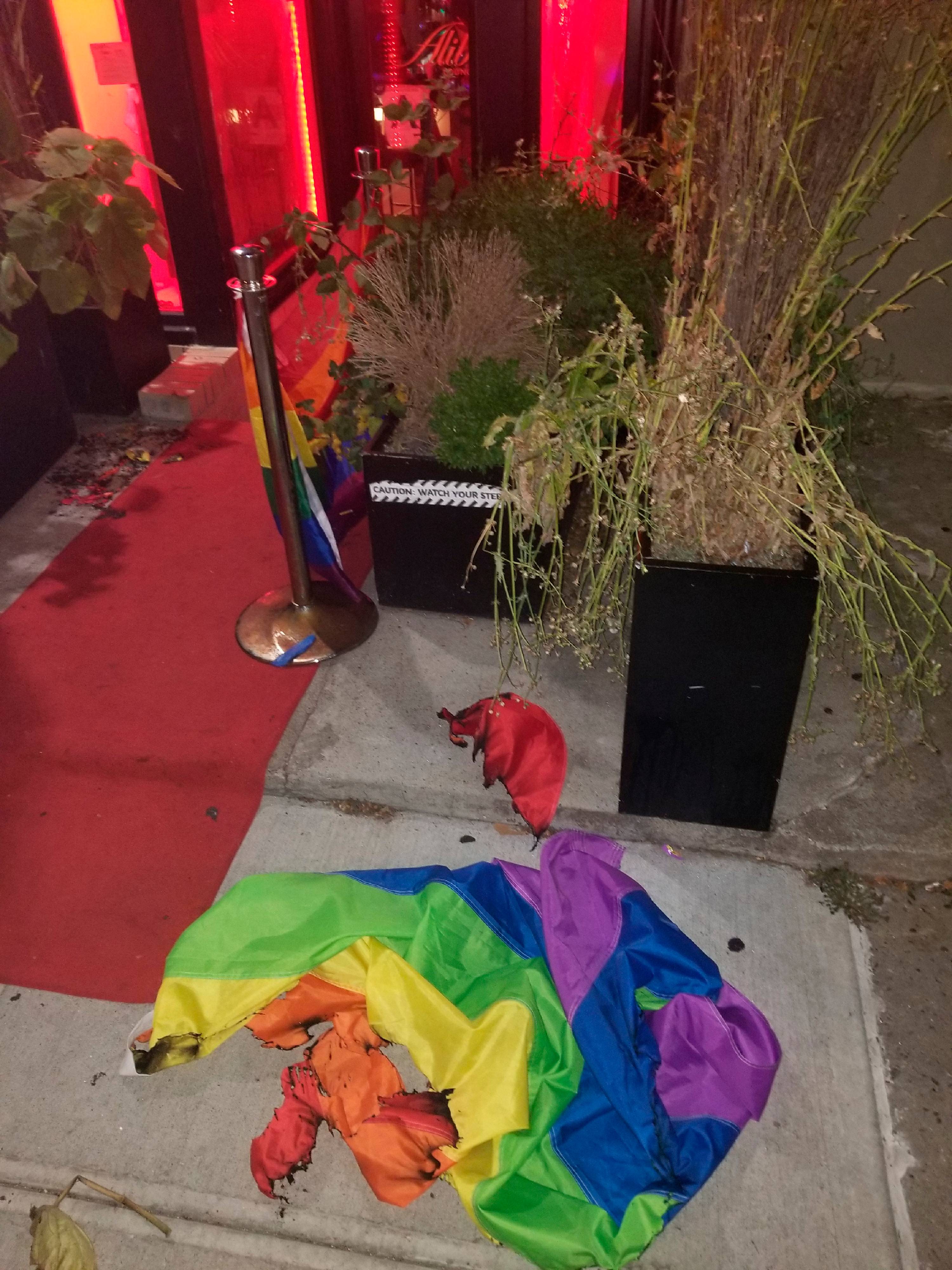
A burned rainbow flag lays on the stoop of the Alibi Lounge, early Monday, July 8, 2019, in New York City. (Alexi Minko via AP)
Skyrocketing Incidents of HateFrom a wave of swastikas and racist taunts to hate-fueled road rage, 'hate at home' is skyrocketing.
A pattern of bias incidents has been uncovered in a first-of-its-kind, two-year 'Turn to Tara' investigation tracking hate in all corners of the Hudson Valley.
In 2017, News 12’s Tara Rosenblum and her investigative team started combing through nearly a decade of data and thousands of public records to
create a database - unlike any other in New York state.
With so many stories of hate crimes, the questions abound is there truly more hate out there? And where is it? Or are we just more sensitive to it and its consequences?
What the team uncovered shows that hate is happening everywhere, who the victims are and where it's happening most.
Video: Hate at Home Overview
The team also worked on an in-depth comparison of incidents before and after the last presidential election. But right off the bat, the team hit a significant roadblock. Turns out incidents of bias in New York are poorly tracked, and there is no reliable national database of hate crimes.
By submitting hundreds of public document requests, combing through thousands of police records, and old-fashioned ground reporting, the team built its own interactive database spanning a decade for the five counties in the News 12 coverage area.
News 12 also partnered with the non-profit newsroom ProPublica who us sent tips from their reporting project documenting hate.
The result is a first-of-its-kind collection of data revealing an explosion of hate crimes in each county of the Hudson Valley. It’s in communities large and small, wealthy and poor, rural and urban.
MAP: Heat Map of Hate Crime Incidents in Westchester/Hudson Valley:
*Note: Only incidents with specific addresses were plotted for data
Included in the database are nearly 600 incidents involving everything from white supremacist recruitment fliers on local college campuses to racist rants on public buses and even cemetery vandalism.
There is also a seemingly neverending wave of swastikas. Over 135 of them painted on cars, tennis courts, train stations, parks and public schools. One of them landing right outside Amelia Navin's high school in Ardsley. “As a Jewish girl from Ardsley, I was not only personally offended, but I was shocked someone in our town would do something like this. I was surprised there would be this level of hate,” says Navin.
Just 15 minutes away, police responded to six reports of swastikas in one month at the Albert Leonard Middle School in New Rochelle. “It makes me really sad. It makes me uncomfortable,” said one student.
In fact, Jewish residents were the most common target in our database, listed in about half of all the cases tracked.
It really makes me sad. It makes me uncomfortable.
The team also searched for solutions to heal our neighborhoods, which took us 6,000 miles away to Israel. News 12 was invited as the only American television station to accompany Gov. Andrew Cuomo on a solidarity mission to the Holy Land. During a rare sit-down interview Cuomo said, “I find this repulsive and repugnant. It has been outrageous, disgusting and it has no place in New York, and I wanted the people in Israel to hear that from me. The way I wanted the people in New York to hear it from me on a personal level. Not a statement from the governor, not a press release,” say Cuomo.
With Neo-Nazi recruitment on college campuses minutes from Cuomo’s house, swastikas in elementary school bathrooms, death threats to Jewish politicians, Rosenblum asked the governor to talk specifics of what New Yorkers and the governor can do to eliminate this culture of hate. “First, it violates the law. And the law is the law. Be more aggressive and more effective in enforcing the law. We have a special state police hate crimes task force, we have new laws, we are enforcing them aggressively. I have said to the people of this state a number of times, this is not going to be taken lightly. We will investigate, we will prosecute, and if you deserve it, you will go to jail. So treat it as it is.”
Cuomo went even further. “Second, protect people; we, for the first time, are doing security grants to religious affiliated centers. Third level, I think is about leadership and dialogue and talking it through with people.”
We will investigate, we will prosecute, and if you deserve it, you will go to jail. So treat it as it is.
But it's not just Jewish families experiencing "hate at home." “I’ve heard things like ‘you are a stupid bloody immigrant,’ ‘a stupid Indian,’ ‘you’re a Muslim terrorist,’ ‘you don't belong with us,’” says Ardsley High School junior Yaman Tmulkar
Also included in the database is several dozen incidents involving the “n” word. And that's not counting the untold number of victims who never speak up.
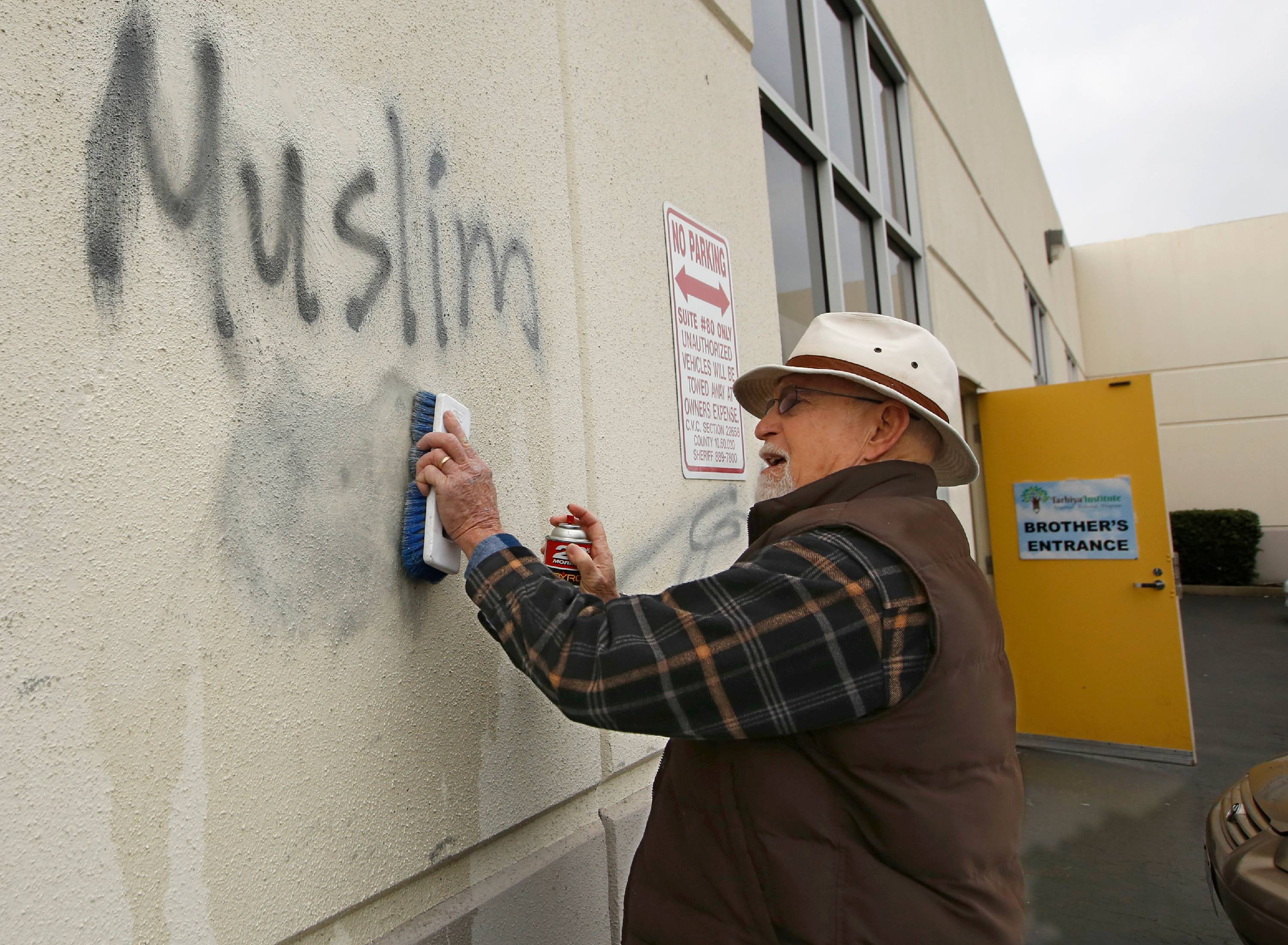
Tom Garing cleans up racist graffiti painted on the side of a mosque in what officials called an apparent hate crime, in Roseville, Calif. (AP Photo/Rich Pedroncelli)
Just under half of the victims are Jewish (45%), followed by African-Americans (12%), members of the LGBTQ community (9%), Hispanics (6%), Caucasians (4%), Catholics (3) and Muslims (2). Asians, Indians, the disabled, and overweight each made up less than 1%.
Plotting the incidents on a map, it's easy to spot the places where hate is most likely to take place. Westchester had the most incidents of all the five counties in the coverage area.
Map: Hate Incidents in Westchester/Hudson Valley (Click Incident for Information):
*Note: Only incidents with specific addresses were plotted for dataBut there is a reason Clarkstown in Rockland County is colored red. Despite it's relatively smaller population, the town leads the entire Hudson Valley in incidents of hate.
A graphic example was an attack in which three individuals police say randomly assaulted Jewish customers at the Palisades Center mall while making anti-Semitic remarks.
The attack was not isolated. Roughly one in 10 incidents the team followed involves violence.
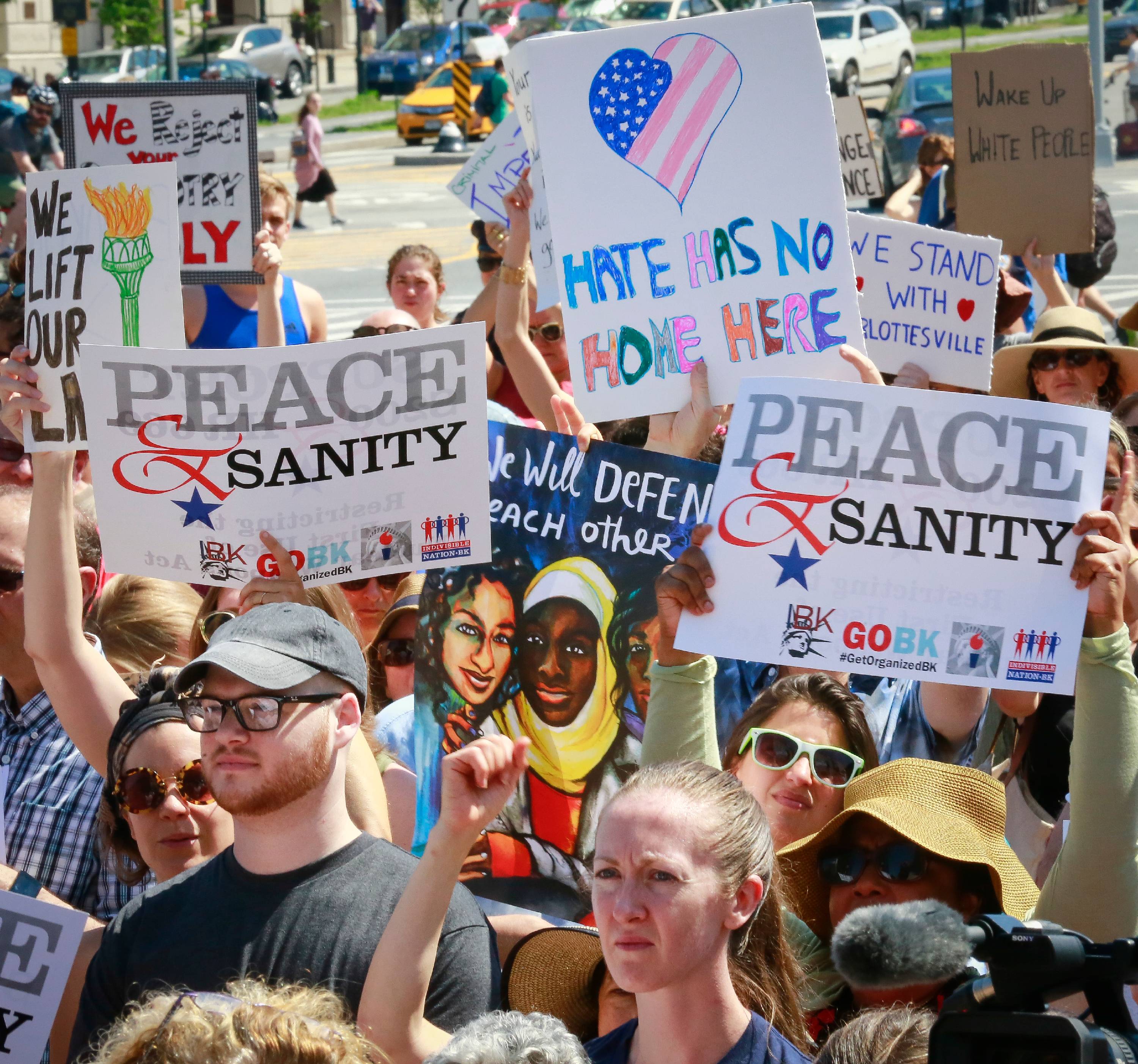
Protesters listen during a "Peace and Sanity" rally in Brooklyn. (AP Photo/Bebeto Matthews)
However, victims say it’s the invisible wounds that can be the hardest to heal. “I feel like really sometimes psychologically hurting someone, emotionally, it can be worse than physical hate crimes because it messes with how a person reacts to things, their mindset, can be more harmful, can affect how a person can deal with the world,” says victim Heeral Mehta. “It makes you feel unwanted, it makes you feel different; it makes you feel like you didn't belong and that feeling you don't belong is very, very scary.”
Our database also shows hate surged the most between 2016 and 2017, when the number of cases nearly tripled.
So what changed?
It makes you feel unwanted, it makes you feel different...
Some pointed the finger at President Donald Trump. “The people that were subtly racist are more emboldened to feel what they … feel deep inside about us. I think it makes people feel emboldened. Kind of like, ‘hey, if my 45th president can do it, I can do it too; and if he feels this way, I can act this way publicly and get away with it.’ I think we should come to a country together,” says one Spanish-speaking student from Port Chester
Blame many Republicans, and even the President himself rejects. While speaking to reporters on July 30, President Trump declared himself to be the "least racist person there is anywhere in the world." He has repeated the claim in numerous interviews and tweets since.
But regardless of who or what is causing it, New Yorkers are fighting back. “We will prosecute everyone to the fullest extent of the law,” says Cuomo. “We are stronger than that hatred. Our unity is stronger than that hatred,” adds Westchester County Executive George Latimer.
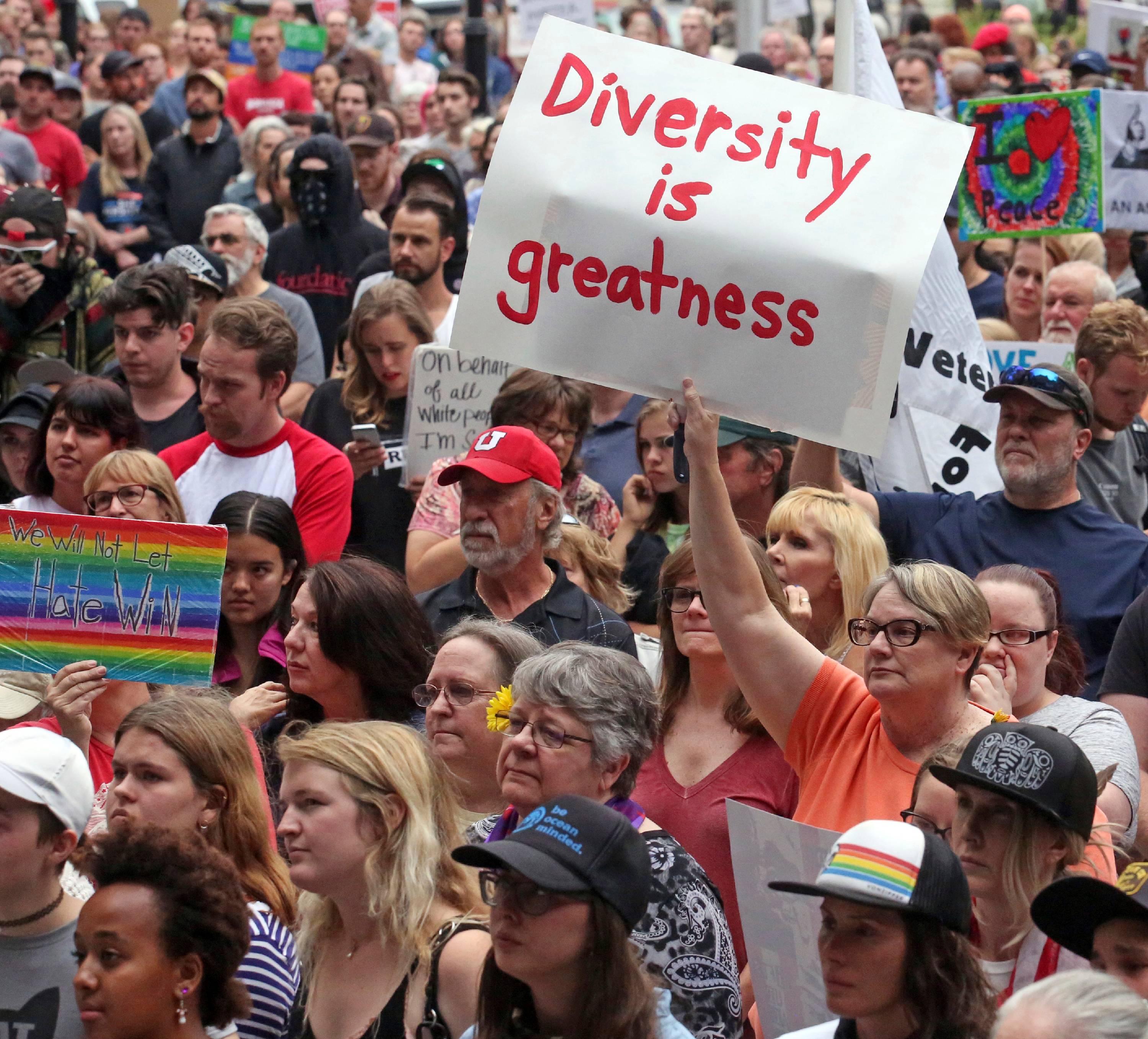
Utah residents held a unity and anti-racism rally Monday night to denounce the messages of hate and violence of white supremacists at a weekend rally in Charlottesville, Va. (AP Photo/Rick Bowmer)
Targeting ReligionIn part three of “Hate at Home,” News 12 explores religious discrimination throughout Westchester and the Hudson Valley.
News 12 has spent the past two years recording hundreds of incidents of vandalism, harassment and physical assaults -
and has published the findings on our website.Video: Fear Among Religious Communities
Our
News 12 database reveals a troubling mosaic of hate directed at Muslims, Latinos and African-Americans. However, the prime target is clear: Out of all the 605 cases News 12 has tracked, nearly half of them -270 - involve incidents of anti-Semitism.
New York City and its suburbs are home to the largest Jewish population in the country – second in the world only to Israel.
The community of more than 1 million strong has come under siege lately with messages of hate. At times, the threats have involved more than just graffiti.
According to the Anti-Defamation League, more than half of all anti-Semitic assaults in the country have occurred in New York.
It reported a particularly troubling spike in 2017, where Jewish-targeted hate surged 90% from the year before – the largest single increase ever recorded.
Racism and bigotry have been around in America for a long time, so what's changed?
"There's an embodiment we've seen across our society, so while in the past those conversations happened behind closed doors, now people feel free to share biased and bigoted views,” says Melanie Robbins, of the New York Anti-Defamation League.
News 12 wanted to know if the numbers were just as staggering closer to home, so Tara Rosenblum put in hundreds of public document requests and reviewed thousands of police documents going back to 2010.
...In the past those conversations happened behind closed doors, now people feel free to share biased and bigoted views...
Sadly, the results showed that the trend is nearly identical. 2017 had the highest number of incidents of all the years News 12 tracked, with 143 incidents, up from just 52 incidents in 2016.
The vast majority of all cases – 135 - involved swastikas that have been splashed across parks, a school and even a Jewish cemetery.
In Rockland, where one in three residents are Jewish - the highest concentration in the state – there were the most incidents of all.
The data caught the attention of New York’s top elected official – Gov. Andrew Cuomo.
Cuomo pledged to fight back against anti-Semitism during a summer solidarity trip to Israel where News 12 was invited as the only American TV station. It was a journey that Cuomo described as extremely personal.
“I grew up in a Jewish community, it's part of New York culture. It’s part of the family of New Yorkers, part of the neighborhood. Two of my sisters married two Jewish men,” he says.
During the rare sitdown interview, the governor admitted he too has felt hate at home
“I have had people say to me ‘What role are you in the “Godfather” movie. Who are you like?" said Cuomo.
While Cuomo refused to assign blame, he was eager to talk solutions.
“I think you have people who are afraid, they are anxious about their situation, they are anxious about their job, they are anxious about their economy and it's easy to get someone to blame. It's easy to take that fear and turn it into anger and I think that's what's happening more and more,” says Cuomo.
In Orange County, District Attorney David Hoovler is confronting hate head-on, organizing a recent awareness seminar in Goshen for members of law enforcement and educators.
I think you have people who are afraid, they are anxious about their situation, they are anxious about their job, they are anxious about their economy and it's easy to get someone to blame.
"Our goal at the end of the day is to make sure people don't use these signs, symbols or speech to intimate another group,” he says.
In Westchester, there are more efforts to teach young people about the past.
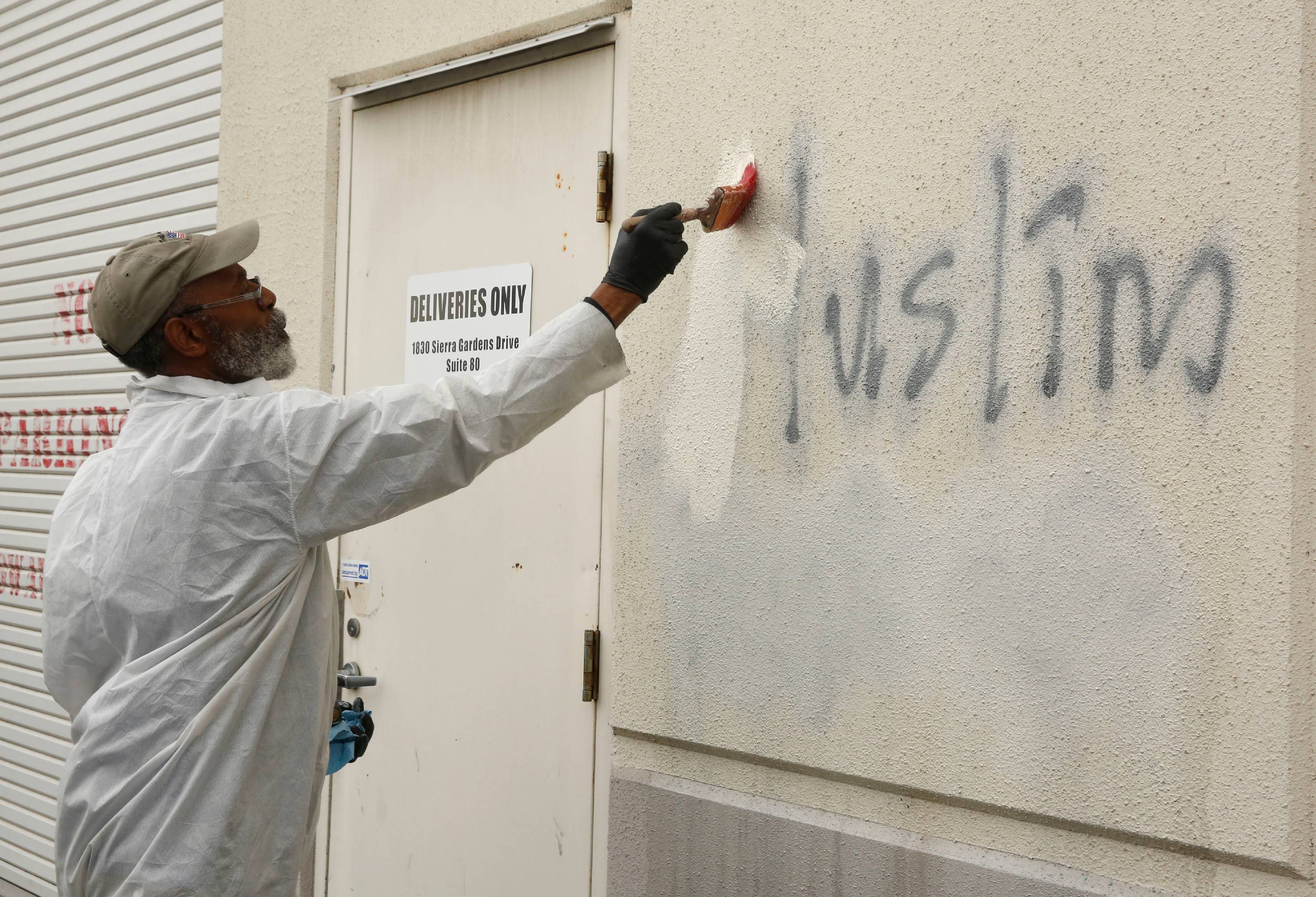
Students Singled Out:
Kids as young as 6 are now victims of hate as a growing crisis spreads throughout the hallways of New York schools. Are educators doing enough to fight back?
For the past two years, the “Turn To Tara” investigative team has been collecting and analyzing thousands of police records and public documents - all involving acts of hate.
Tara Rosenblum’s team has discovered a dramatic increase in racially charged harassment at Hudson Valley schools, with students increasingly being singled out due to their religion, sexuality and race.
Video: Hate in Our Schools
They found that the Hudson Valley is home to some of the most affluent, highest ranking school districts in America, but there is an untold story of hate simmering right beneath the surface. School yards have been transformed into havens for harassment and hate with young victims often too fearful to speak up and fight back against the intolerance.
However, a few brave victims are fighting back. "I want to be the last person in Minisink and Orange County and New York to ever have to go through this," says N'senga Kinzonsi.
While wiping away tears, Kinzonsi is taking her painful story public for the first time.
"During my English class, I was reaching into my backpack to pull out the book that we were reading when the picture was taken of me." Much to her horror, that picture, snapped last fall by a fellow Minisink Valley High School student, would wind up on Snapchat only minutes later, with a caption of the n-word, calling for her to be lynched.
I want to be the last person in Minisink and Orange County and New York to ever have to go through this.
"I was shocked and saddened," says Kinzonsi.
While Kinzonsi’s story is unnerving and unthinkable, she is far from the only student to become target of racism at school this year. Just a few months later, a Mamaroneck father told the school board a student called his 10-year-old daughter the n word.
"My daughter was a called a [offensive word] by a white boy in an after school club." What was more shocking was the lack of response by the school. "It took 30 days to finally meet with the principal," says the father.
The problem is not isolated to Mamaroneck or Minisink.
For the past two years, our investigative unit has been gathering viewers’ stories and analyzing thousands of police records and public documents.
In a first-of-its-kind data project, the team’s goal was get a big picture look at bias and hate crimes in our backyard.
We don't take this lightly, and more than anything we're disappointed because we know the majority of our students know better.
The team quickly noticed the number of incidents playing out at local schools including swastikas at schools in Hastings-on-Hudson, Katonah, Cross River, Chappaqua and many others. There was also Nazi propaganda found at SUNY Purchase and anti-Semitic posters found on four other college campuses.
Out of the 605 incidents in the Hate at Home database, roughly 1 out of 4 played out in the places where our children are supposed to feel the safest. And that's not including countless victims who are too afraid to report.
In some cases, we are seeing the same schools victimized over and over again.
For the sixth time in one month, police responded to Albert Leonard Middle School in New Rochelle after the discovery of a swastika, this one etched on a bathroom wall.
"We don't take this lightly, and more than anything we're disappointed because we know the majority of our students know better," says Interim School Superintendent Magda Parvey.
After the wave of swastikas, school leaders brought in experts to teach lessons about the horrors of the Holocaust. "It's very eye-opening, you don't really know the stuff until you learn about it,” said one student to News 12.
The data proves hate is happening in school districts rich and poor, small and large.
In some cases, the harassment extends beyond just name-calling. Sleepy Hollow's first openly gender-queer student Spirit Goodwin, who doesn't identify as male or female, told us a story of being attacked with bottles by a group of fellow students last year.
“It's hard to not know what you are,” says Goodwin.
Goodwin survived the attack, but will the next victim?
Department of Education data shows 1 in 4 American students saw hate-related graffiti at school in 2017. That same year showed the largest spike in hate incidents out of the 10 years we tracked for our project.
It concerns me greatly. And we need to be very vigilant.
Religious leaders and elected officials warn there is a danger in staying silent. "We take these incidents very seriously, we don't just think about this as kids being kids," says Rabbi David Schuck, of Beth El Synagogue.
“It concerns me greatly. And we need to be very vigilant,” says state Sen. Shelley Mayer, chairwoman of the Senate Education Committee.
So what can educators do to fight back? “I think one of the biggest advantages you can have against hate is identifying it when you see it. Not letting it escape [or] wiggle away and shine a bright light on it,” says White Plains Superintendent Dr. Joseph Ricca.
Dr. Ricca, who oversees one of the most diverse districts in the Hudson valley, was one of the first educators that we shared the data with.
“I think in a lot of areas we are seeing a lot of ratcheting up with heated conversations. A lot of heart, not a lot of light, people are very polarized. That’s a problem but it’s an adult problem and we need to fix it on that level so kids can grow up to see role models doing the right thing,” says Ricca.
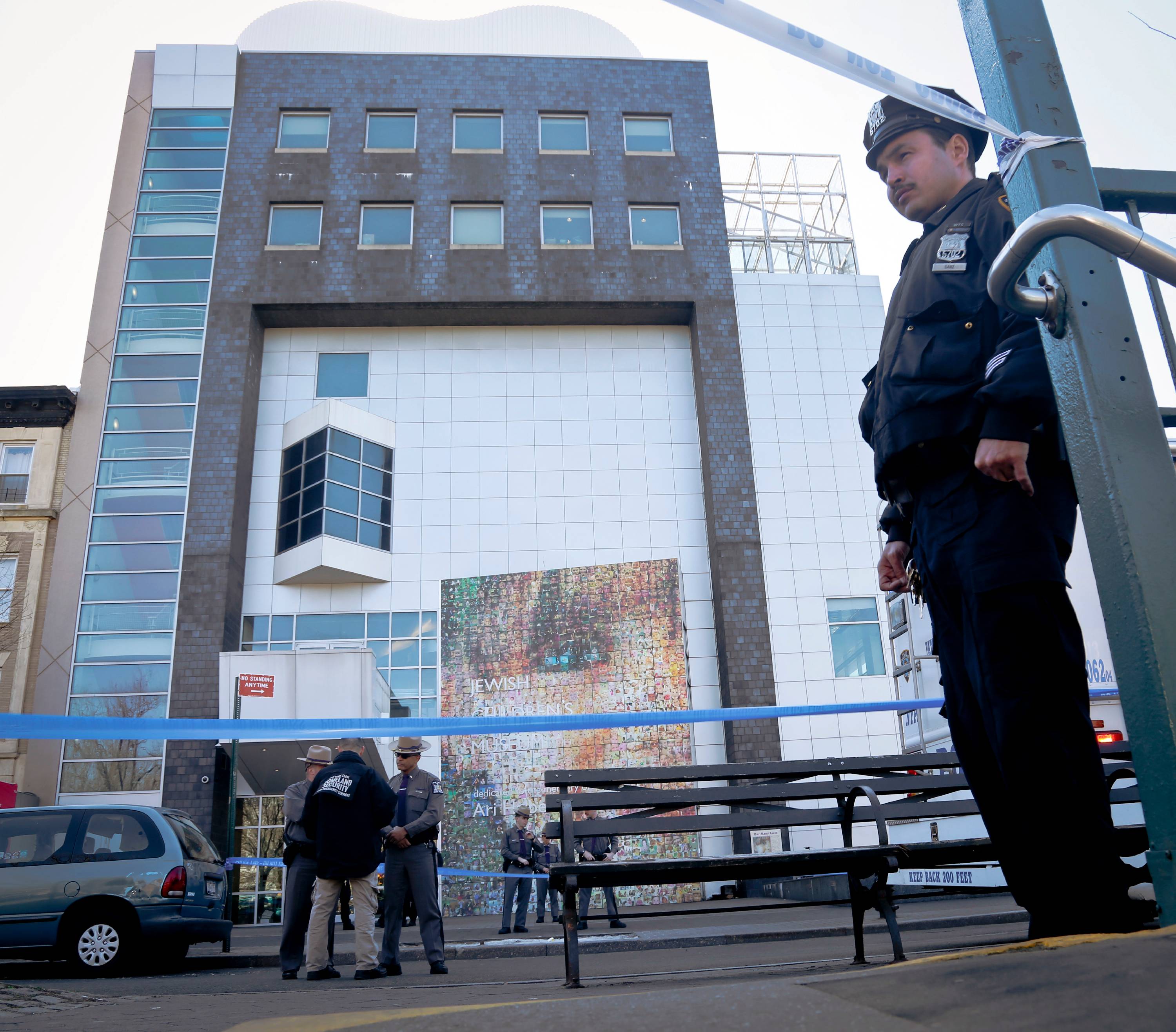
Federal, state and local law enforcement stand outside the Jewish Children's Museum following a bomb threat, Thursday March 9, 2017 in Brooklyn
Enforcement Challenges
A swastika carved into a Nyack Starbucks bathroom wall. A noose hanging in an Ossining park. A racially charged road-rage incident caught on camera in Ulster County. They are just a few examples of the hate that seems to be happening all over the Hudson Valley.
Our Turn to Tara investigative unit has spent the past two years looking at the data, and we've uncovered 605 bias incidents dating back a decade.
Video: The Burden of Proof
The database shows a bias incident happens at least one out of every six days in our area. But not all of these incidents lead to a police report.
According to FBI numbers, some of our largest municipalities have gone years without a reported hate crime. Scarsdale, North Castle, New Castle, Goshen, Newburgh, New Windsor and White Plains are just some of the communities that show zero hate crimes going back several years.
So how can this be? We took that question to White Plains Public Safety Commissioner David Chong. "We're lucky here in White Plains we've had no reported hate crimes," says Chong.
So how can it be that a city of almost 60,000 people doesn’t have a single incident of hate since 2012? "I say that No. 1 is, we can't report something that's not reported to us. So the numbers are the numbers. Nobody is reporting any hate crimes to us, and we're not coming across people that are saying they're being victimized by hate," says Chong.
Jirandy Martinez, executive director of the Community Resource Center in Mamaroneck, an advocacy group that assists some 4,000 immigrants a year, thinks many victims are keeping their mouths shut. "We know that crimes are happening. We know people are in general unsafe sometimes ... I know our communities would rather not report those crimes. Hate crimes make our communities unsafe, they really make us question where we live as a society," says Martinez.
So what exactly is a hate crime? It can be a lot of different things. One example is that New York state law says placing a swastika or noose on public property is a hate crime. But even then, "We have to determine, No. 1, the person that's committing whatever they're committing, is it truly hateful or is it spur of the moment," says Chong. The swastika found in a Nyack Starbucks is still an open case with no suspect … and therefore no prosecution.
Hate crimes make our communities unsafe, they really make us question where we live as a society.
The rope hanging in an Ossining park was determined not to be a noose but left over from a fair the night before.
The road-rage altercation in Ulster County? The victim never pressed charges so there is no police report.
One thing that hinders hate crime prosecution is actually one of America’s most precious foundations - the First Amendment right of freedom of religion, speech, press, petition and assembly.
It's Westchester County District Attorney Anthony Scarpino's job to prosecute all crimes. He says Westchester County, with a population of almost a million people, had 24 hate crimes reported in 2018 and 15 so far this year. But is that the real number?
"There are people who do things that may be hate crimes, or may be just bad manners, and we have to try to address them and investigate them," says Scarpino.
"It hurts me. It significantly hurts me that my community is being affected.
He says solving hate crimes so they can actually be prosecuted has its own challenges. "Many times the first problem is trying to identify the individuals that did it. Because for us to determine that it's a hate crime we have to know the motivation of it."
This results in even fewer prosecutions of already low numbers of reported cases.
Digging deeper into the database, it’s found that Yonkers, a diverse community of 200,000, had just five reported hate crime cases in 2016 - the same number as New Rochelle. In the village of Monroe in Rockland County, a population of 8,000 but home to a large Hasidic population where many feel anti-Semitism runs deep, there were just three hate crime incidents in 2016. So why the disparity? "All these different groups use different calculations as to what is a hate crime and what is not, so it's hard for me to really comment on what is the matrix that they are using," says Scarpino.
One thing Jirandy Martinez knows for sure is that people are suffering in silence. "It hurts me. It significantly hurts me that my community is being affected."
Project Credits:
Pauline Chiou: Assistant News Director, News 12 Westchester/Hudson Valley
Lee Danuff: Digital Producer
Paul Farnsworth: Digital Producer
Alan Flamenhaft: Editor
Syed Imam: Developer
Scott McGee: Anchor
Frank Pokorney: News 12 Digital Executive Producer
Tara Rosenblum: Investigative Reporter
Jean Salzarulo: Assignment Desk Editor
Manoj Shamdasani: Vice President, Local News
Chris Vaccaro: Vice President, News 12 Digital




























